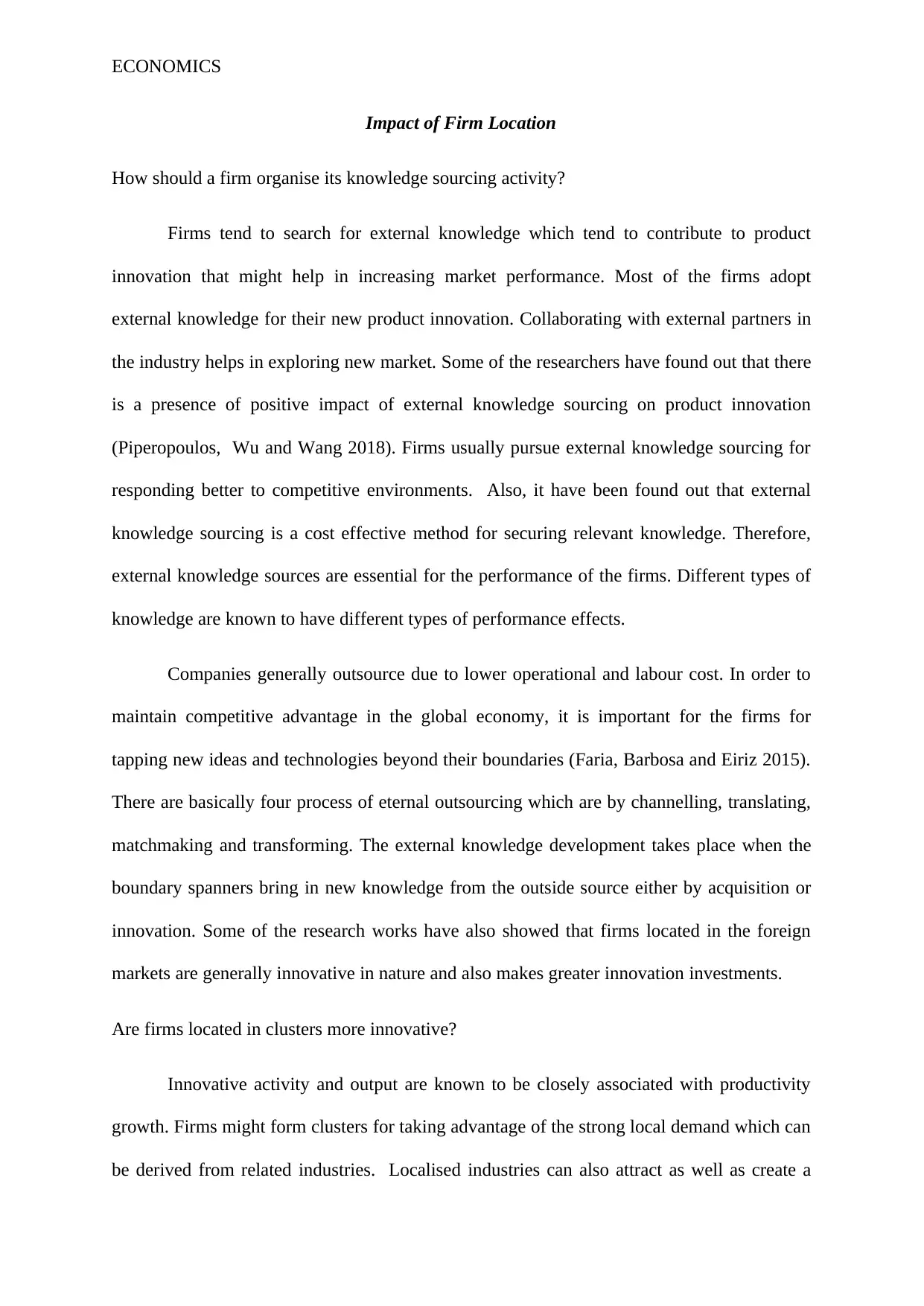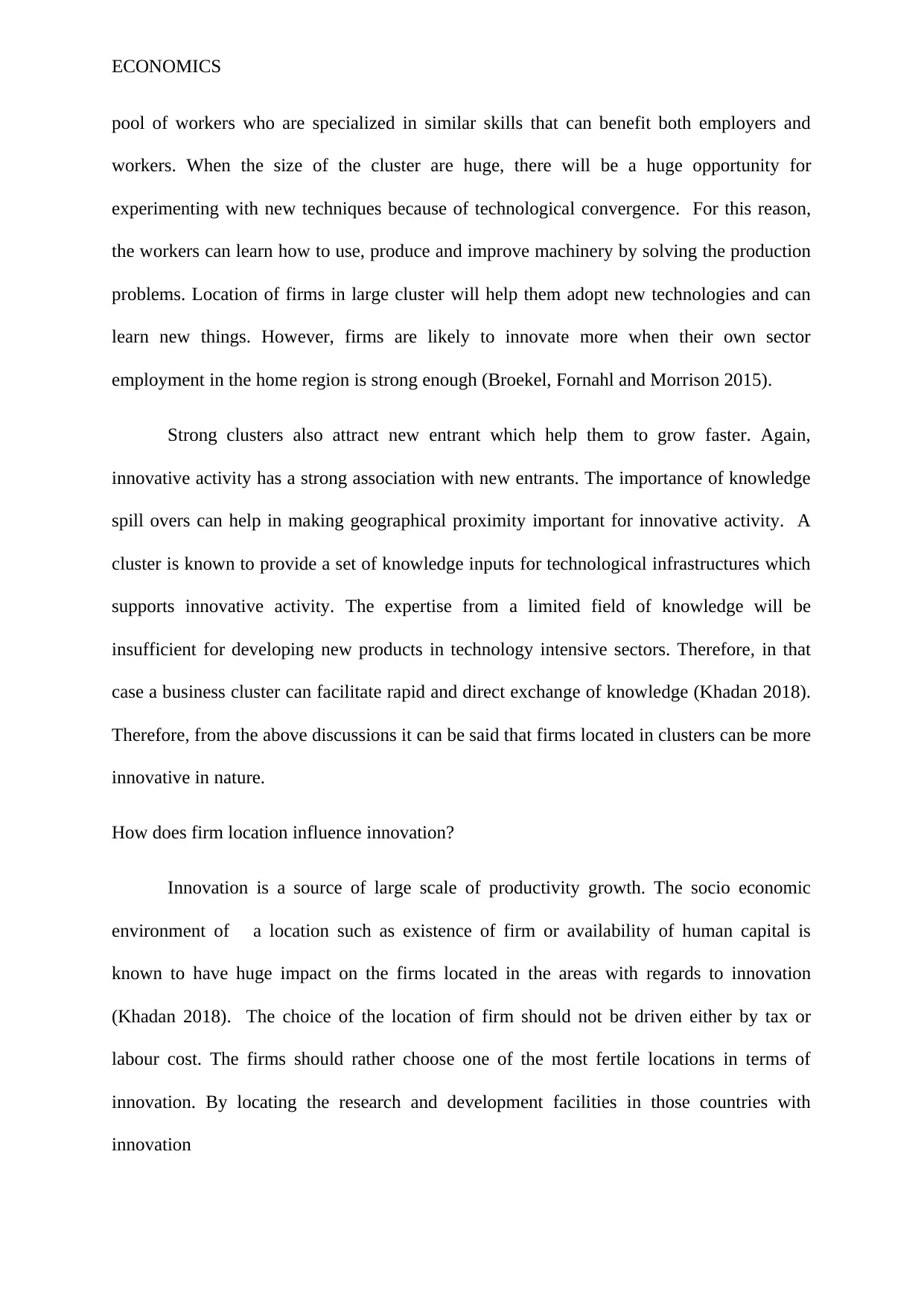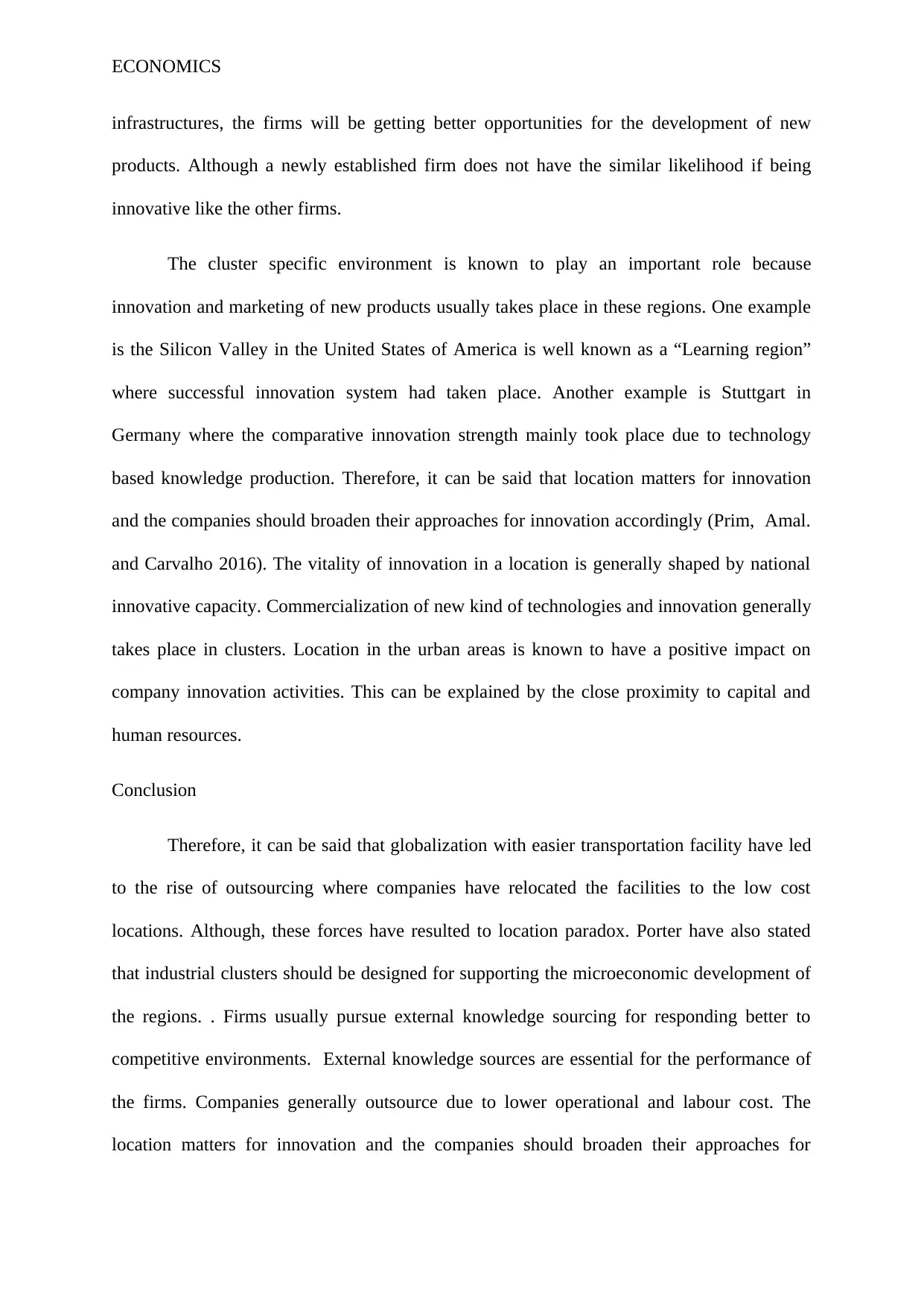Economics: Firm Location's Influence on Innovation and Sourcing
VerifiedAdded on 2023/01/10
|7
|1315
|95
Essay
AI Summary
This economics essay explores the impact of firm location on innovation and knowledge sourcing activities. It examines how firms leverage external knowledge to enhance product innovation and market performance, emphasizing the role of outsourcing and collaboration. The essay discusses the benefits of firm location in clusters, highlighting how they foster innovation through knowledge spillovers and access to specialized labor. It further analyzes how firm location influences innovation by considering factors like socio-economic environment and the availability of human capital, and the importance of innovation infrastructures. The essay concludes by underscoring the significance of industrial clusters and the impact of globalization and outsourcing on firm location decisions, emphasizing the importance of strategic location choices for maximizing innovation potential. It also provides examples of successful innovation ecosystems in locations like Silicon Valley and Stuttgart.

Running head: ECONOMICS
Economics
Name of the student
Name of the university
Author note
Economics
Name of the student
Name of the university
Author note
Paraphrase This Document
Need a fresh take? Get an instant paraphrase of this document with our AI Paraphraser

ECONOMICS
Impact of Firm Location
How should a firm organise its knowledge sourcing activity?
Firms tend to search for external knowledge which tend to contribute to product
innovation that might help in increasing market performance. Most of the firms adopt
external knowledge for their new product innovation. Collaborating with external partners in
the industry helps in exploring new market. Some of the researchers have found out that there
is a presence of positive impact of external knowledge sourcing on product innovation
(Piperopoulos, Wu and Wang 2018). Firms usually pursue external knowledge sourcing for
responding better to competitive environments. Also, it have been found out that external
knowledge sourcing is a cost effective method for securing relevant knowledge. Therefore,
external knowledge sources are essential for the performance of the firms. Different types of
knowledge are known to have different types of performance effects.
Companies generally outsource due to lower operational and labour cost. In order to
maintain competitive advantage in the global economy, it is important for the firms for
tapping new ideas and technologies beyond their boundaries (Faria, Barbosa and Eiriz 2015).
There are basically four process of eternal outsourcing which are by channelling, translating,
matchmaking and transforming. The external knowledge development takes place when the
boundary spanners bring in new knowledge from the outside source either by acquisition or
innovation. Some of the research works have also showed that firms located in the foreign
markets are generally innovative in nature and also makes greater innovation investments.
Are firms located in clusters more innovative?
Innovative activity and output are known to be closely associated with productivity
growth. Firms might form clusters for taking advantage of the strong local demand which can
be derived from related industries. Localised industries can also attract as well as create a
Impact of Firm Location
How should a firm organise its knowledge sourcing activity?
Firms tend to search for external knowledge which tend to contribute to product
innovation that might help in increasing market performance. Most of the firms adopt
external knowledge for their new product innovation. Collaborating with external partners in
the industry helps in exploring new market. Some of the researchers have found out that there
is a presence of positive impact of external knowledge sourcing on product innovation
(Piperopoulos, Wu and Wang 2018). Firms usually pursue external knowledge sourcing for
responding better to competitive environments. Also, it have been found out that external
knowledge sourcing is a cost effective method for securing relevant knowledge. Therefore,
external knowledge sources are essential for the performance of the firms. Different types of
knowledge are known to have different types of performance effects.
Companies generally outsource due to lower operational and labour cost. In order to
maintain competitive advantage in the global economy, it is important for the firms for
tapping new ideas and technologies beyond their boundaries (Faria, Barbosa and Eiriz 2015).
There are basically four process of eternal outsourcing which are by channelling, translating,
matchmaking and transforming. The external knowledge development takes place when the
boundary spanners bring in new knowledge from the outside source either by acquisition or
innovation. Some of the research works have also showed that firms located in the foreign
markets are generally innovative in nature and also makes greater innovation investments.
Are firms located in clusters more innovative?
Innovative activity and output are known to be closely associated with productivity
growth. Firms might form clusters for taking advantage of the strong local demand which can
be derived from related industries. Localised industries can also attract as well as create a

ECONOMICS
pool of workers who are specialized in similar skills that can benefit both employers and
workers. When the size of the cluster are huge, there will be a huge opportunity for
experimenting with new techniques because of technological convergence. For this reason,
the workers can learn how to use, produce and improve machinery by solving the production
problems. Location of firms in large cluster will help them adopt new technologies and can
learn new things. However, firms are likely to innovate more when their own sector
employment in the home region is strong enough (Broekel, Fornahl and Morrison 2015).
Strong clusters also attract new entrant which help them to grow faster. Again,
innovative activity has a strong association with new entrants. The importance of knowledge
spill overs can help in making geographical proximity important for innovative activity. A
cluster is known to provide a set of knowledge inputs for technological infrastructures which
supports innovative activity. The expertise from a limited field of knowledge will be
insufficient for developing new products in technology intensive sectors. Therefore, in that
case a business cluster can facilitate rapid and direct exchange of knowledge (Khadan 2018).
Therefore, from the above discussions it can be said that firms located in clusters can be more
innovative in nature.
How does firm location influence innovation?
Innovation is a source of large scale of productivity growth. The socio economic
environment of a location such as existence of firm or availability of human capital is
known to have huge impact on the firms located in the areas with regards to innovation
(Khadan 2018). The choice of the location of firm should not be driven either by tax or
labour cost. The firms should rather choose one of the most fertile locations in terms of
innovation. By locating the research and development facilities in those countries with
innovation
pool of workers who are specialized in similar skills that can benefit both employers and
workers. When the size of the cluster are huge, there will be a huge opportunity for
experimenting with new techniques because of technological convergence. For this reason,
the workers can learn how to use, produce and improve machinery by solving the production
problems. Location of firms in large cluster will help them adopt new technologies and can
learn new things. However, firms are likely to innovate more when their own sector
employment in the home region is strong enough (Broekel, Fornahl and Morrison 2015).
Strong clusters also attract new entrant which help them to grow faster. Again,
innovative activity has a strong association with new entrants. The importance of knowledge
spill overs can help in making geographical proximity important for innovative activity. A
cluster is known to provide a set of knowledge inputs for technological infrastructures which
supports innovative activity. The expertise from a limited field of knowledge will be
insufficient for developing new products in technology intensive sectors. Therefore, in that
case a business cluster can facilitate rapid and direct exchange of knowledge (Khadan 2018).
Therefore, from the above discussions it can be said that firms located in clusters can be more
innovative in nature.
How does firm location influence innovation?
Innovation is a source of large scale of productivity growth. The socio economic
environment of a location such as existence of firm or availability of human capital is
known to have huge impact on the firms located in the areas with regards to innovation
(Khadan 2018). The choice of the location of firm should not be driven either by tax or
labour cost. The firms should rather choose one of the most fertile locations in terms of
innovation. By locating the research and development facilities in those countries with
innovation
⊘ This is a preview!⊘
Do you want full access?
Subscribe today to unlock all pages.

Trusted by 1+ million students worldwide

ECONOMICS
Paraphrase This Document
Need a fresh take? Get an instant paraphrase of this document with our AI Paraphraser

ECONOMICS
infrastructures, the firms will be getting better opportunities for the development of new
products. Although a newly established firm does not have the similar likelihood if being
innovative like the other firms.
The cluster specific environment is known to play an important role because
innovation and marketing of new products usually takes place in these regions. One example
is the Silicon Valley in the United States of America is well known as a “Learning region”
where successful innovation system had taken place. Another example is Stuttgart in
Germany where the comparative innovation strength mainly took place due to technology
based knowledge production. Therefore, it can be said that location matters for innovation
and the companies should broaden their approaches for innovation accordingly (Prim, Amal.
and Carvalho 2016). The vitality of innovation in a location is generally shaped by national
innovative capacity. Commercialization of new kind of technologies and innovation generally
takes place in clusters. Location in the urban areas is known to have a positive impact on
company innovation activities. This can be explained by the close proximity to capital and
human resources.
Conclusion
Therefore, it can be said that globalization with easier transportation facility have led
to the rise of outsourcing where companies have relocated the facilities to the low cost
locations. Although, these forces have resulted to location paradox. Porter have also stated
that industrial clusters should be designed for supporting the microeconomic development of
the regions. . Firms usually pursue external knowledge sourcing for responding better to
competitive environments. External knowledge sources are essential for the performance of
the firms. Companies generally outsource due to lower operational and labour cost. The
location matters for innovation and the companies should broaden their approaches for
infrastructures, the firms will be getting better opportunities for the development of new
products. Although a newly established firm does not have the similar likelihood if being
innovative like the other firms.
The cluster specific environment is known to play an important role because
innovation and marketing of new products usually takes place in these regions. One example
is the Silicon Valley in the United States of America is well known as a “Learning region”
where successful innovation system had taken place. Another example is Stuttgart in
Germany where the comparative innovation strength mainly took place due to technology
based knowledge production. Therefore, it can be said that location matters for innovation
and the companies should broaden their approaches for innovation accordingly (Prim, Amal.
and Carvalho 2016). The vitality of innovation in a location is generally shaped by national
innovative capacity. Commercialization of new kind of technologies and innovation generally
takes place in clusters. Location in the urban areas is known to have a positive impact on
company innovation activities. This can be explained by the close proximity to capital and
human resources.
Conclusion
Therefore, it can be said that globalization with easier transportation facility have led
to the rise of outsourcing where companies have relocated the facilities to the low cost
locations. Although, these forces have resulted to location paradox. Porter have also stated
that industrial clusters should be designed for supporting the microeconomic development of
the regions. . Firms usually pursue external knowledge sourcing for responding better to
competitive environments. External knowledge sources are essential for the performance of
the firms. Companies generally outsource due to lower operational and labour cost. The
location matters for innovation and the companies should broaden their approaches for

ECONOMICS
innovation accordingly. It have also been found out that firms which are located in clusters
are more innovative in nature. Examples from the Silicon Valley in USA and Germany have
showed that firms located in industrial clusters are more innovative in nature.
Reference list
Broekel, T., Fornahl, D. and Morrison, A., 2015. Another cluster premium: Innovation
subsidies and R&D collaboration networks. Research policy, 44(8), pp.1431-1444.
Camisón, C., Forés, B. and Boronat-Navarro, M., 2017. Cluster and firm-specific antecedents
of organizational innovation. Current Issues in Tourism, 20(6), pp.617-646.
Faria, A.P., Barbosa, N. and Eiriz, V., 2015. Firm Innovation and Co‐Location in Portugal.
Growth and Change, 46(4), pp.574-592.
Khadan, J., 2018. Estimating the effects of human capital constraints on innovation in the
Caribbean. Economies, 6(2), p.33.
Lien, Y.C. and Filatotchev, I., 2015. Ownership characteristics as determinants of FDI
location decisions in emerging economies. Journal of World Business, 50(4), pp.637-650.
Piperopoulos, P., Wu, J. and Wang, C., 2018. Outward FDI, location choices and innovation
performance of emerging market enterprises. Research Policy, 47(1), pp.232-240.
Prim, A.L., Amal, M. and Carvalho, L., 2016. Regional cluster, innovation and export
performance: an empirical study. BAR-Brazilian Administration Review, 13(2).
Wallin, T., 2017. An empirical study of firms’ absorptive capacity and export diversification.
The Royal Institute of Technology, Centre of Excellence for Science and Innovation Studies
(CESIS).
innovation accordingly. It have also been found out that firms which are located in clusters
are more innovative in nature. Examples from the Silicon Valley in USA and Germany have
showed that firms located in industrial clusters are more innovative in nature.
Reference list
Broekel, T., Fornahl, D. and Morrison, A., 2015. Another cluster premium: Innovation
subsidies and R&D collaboration networks. Research policy, 44(8), pp.1431-1444.
Camisón, C., Forés, B. and Boronat-Navarro, M., 2017. Cluster and firm-specific antecedents
of organizational innovation. Current Issues in Tourism, 20(6), pp.617-646.
Faria, A.P., Barbosa, N. and Eiriz, V., 2015. Firm Innovation and Co‐Location in Portugal.
Growth and Change, 46(4), pp.574-592.
Khadan, J., 2018. Estimating the effects of human capital constraints on innovation in the
Caribbean. Economies, 6(2), p.33.
Lien, Y.C. and Filatotchev, I., 2015. Ownership characteristics as determinants of FDI
location decisions in emerging economies. Journal of World Business, 50(4), pp.637-650.
Piperopoulos, P., Wu, J. and Wang, C., 2018. Outward FDI, location choices and innovation
performance of emerging market enterprises. Research Policy, 47(1), pp.232-240.
Prim, A.L., Amal, M. and Carvalho, L., 2016. Regional cluster, innovation and export
performance: an empirical study. BAR-Brazilian Administration Review, 13(2).
Wallin, T., 2017. An empirical study of firms’ absorptive capacity and export diversification.
The Royal Institute of Technology, Centre of Excellence for Science and Innovation Studies
(CESIS).
⊘ This is a preview!⊘
Do you want full access?
Subscribe today to unlock all pages.

Trusted by 1+ million students worldwide

ECONOMICS
1 out of 7
Related Documents
Your All-in-One AI-Powered Toolkit for Academic Success.
+13062052269
info@desklib.com
Available 24*7 on WhatsApp / Email
![[object Object]](/_next/static/media/star-bottom.7253800d.svg)
Unlock your academic potential
Copyright © 2020–2025 A2Z Services. All Rights Reserved. Developed and managed by ZUCOL.





